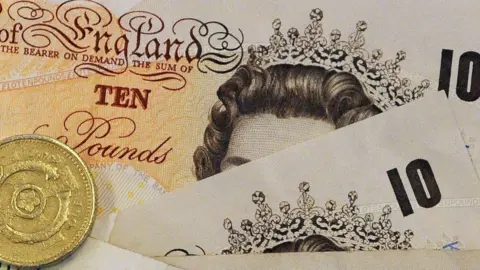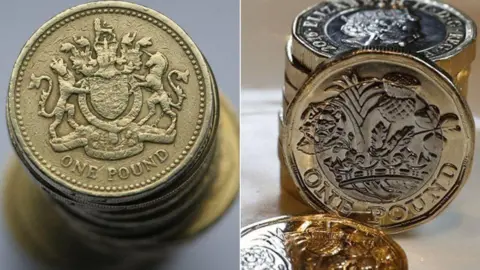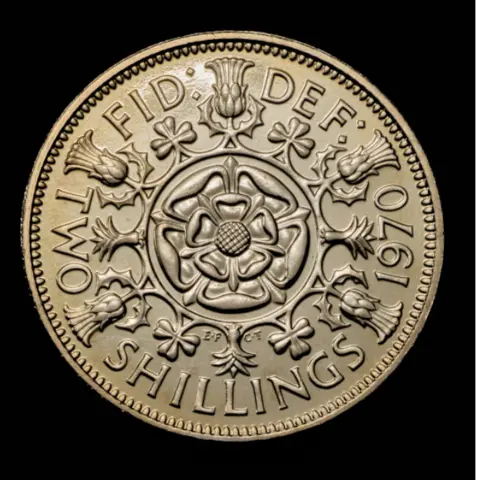£6.6bn in old UK banknotes and coins not cashed in
 PA Media
PA MediaAbout £6.6bn in old banknotes has not been cashed in across the UK, even though the paper £20 and £50 stopped being legal tender in October 2022.
Paper banknotes have been replaced with plastic notes with a series of security features.
Around £600m in old notes has been returned over the last year, and the Bank of England said withdrawn banknotes could still be deposited or exchanged.
There are also 70 million old £1 coins that have not been returned, according to the Royal Mint, with about six million returned over the past year.
The Royal Mint also revealed that over 2.6m old coins of eight other denominations have been returned over the last decade, including halfcrown, florin, shilling and sixpence.
 Getty Images
Getty ImagesDetails of the cash still in circulation or hiding in homes was revealed in Freedom of Information requests by BBC Wales.
The Bank of England said 375 million paper banknotes remained in circulation:
- 109 million £5 notes
- 60 million £10 notes
- 160 million £20 notes
- 46 million £50 notes
Over the last year, about £600 million in old notes has been returned, including one million £5 notes, two million £10 notes, 11 million £20 notes and six million £50 notes.
Paper £5 notes were withdrawn in May 2017, the paper £10 notes in March 2018 and paper £20 and £50 notes on 30 September 2022.
 Getty Images
Getty ImagesIn addition to the paper cash, the Royal Mint, which is based in Llantrisant, Rhondda Cynon Taf, said about 70 million old style £1 coins had not been returned.
However, about six million have been returned over the past year.
Out of the 1.6 billion that have been returned, about 1.8 million were counterfeit.
The round £1 coin was replaced by the 12-sided version in October 2017. The old style coin can still be deposited at the Post Office but cannot be spent.
According to the Royal Mint, which is owned by the UK Treasury, about 138 million round £1 coins have been melted down to make some of the new ones.
 BANK OF ENGLAND
BANK OF ENGLANDThe other denominations returned to the Royal Mint over the last decade are:
- Halfcrown - a denomination worth 1⁄8 pound, or two shillings and six pence. 356,587 returned over last decade. Stopped being legal tender on 1 January 1970
- Florin (two shillings) - 11,716 returned over last decade. Stopped being legal tender on 30 June 1993
- Shilling - 43,299 returned over last decade. Stopped being legal tender on 31 December 1990
- Sixpence - worth 1⁄40 of a pound or half a shilling. 771,899 returned over last decade. Stopped being legal tender on 30 June 1980
- Threepence - 99,765 returned over last decade. Stopped being legal tender on 31 August 1971
- Penny - 165,527 returned over last decade. Stopped being legal tender on 31 August 1971
- Pre-decimal halfpenny - 153,404 returned over last decade. Stopped being legal tender on 1 August 1969
- Decimal halfpenny - 998,466 returned over last decade. stopped being legal tender on 31 December 1984
 Royal Mint
Royal MintThe polymer £50 note featuring the portrait of wartime codebreaker and computer pioneer Alan Turing entered circulation on 23 June 2021, meaning the Bank of England's entire collection of currently-printed banknotes is made of plastic.
While the paper notes are no longer legal tender, a spokeswoman said “all genuine Bank of England banknotes that have been withdrawn from circulation retain their face value. There is no expiry on the period in which we will exchange banknotes”.
They can be returned to some banks and some post offices, but the latter will only exchange a maximum of £300.
People can also post old notes to the Bank of England in the City of London to be paid into a bank account, by cheque or, “if you live in the UK and the amount is under £300”, swapped for new-style polymer ones.
Old notes can also be taken there in person but the bank warned that "our counter can get very busy".
The use of cash fell sharply during the coronavirus pandemic as lockdowns reduced options for spending, and this accelerated a downward trend for the use of notes and coins.
However, cash still accounted for 12% of all payments in 2023, according to the latest figures by banking trade body UK Finance, making it the second most-popular way to pay after debit cards.
